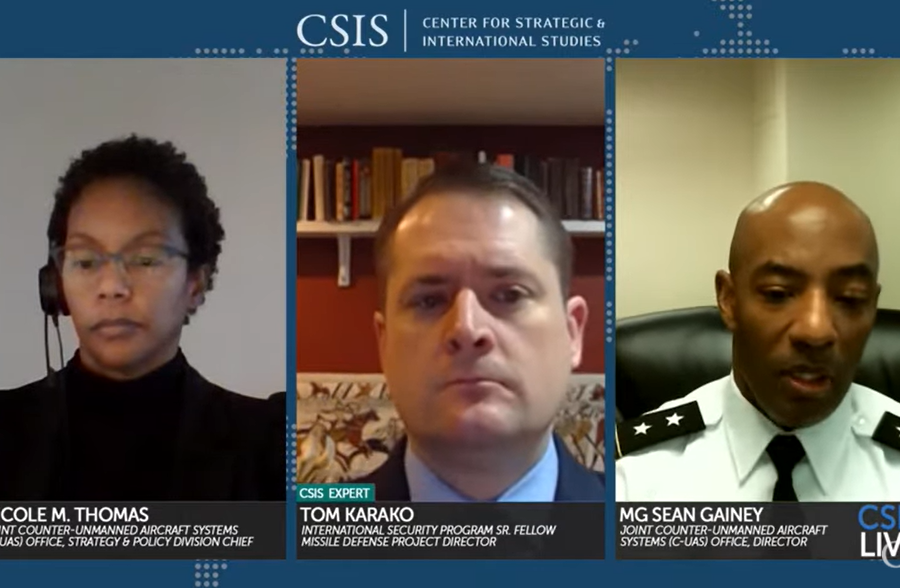The Defense Department is moving out with its first strategy to coordinate and plan for future threats posed by small drones at home and abroad. The Jan. 7 strategy comes after the military has contended with years-long proliferation of quadcopters and other cheap, widely available aircraft that can easily ferry a weapon or spy on Americans.
It looks to fill the gaps in splintered service-focused efforts to protect bases and troops from a low-tech problem, and offer a more holistic solution centered on joint training and doctrine rather than procurement. The Pentagon classifies small unmanned aircraft, or those in UAS Groups 1 and 2, as those that weigh up to 55 pounds.
Three new lines of effort will prepare the military to understand and address UASes, defend those military assets, and work with other U.S. entities and those abroad on protection protocols.
DOD will start looking at the threat posed by small drones on a regional basis around the globe and at home, rather than pursuing a one-size-fits-all solution, an indication of the problem’s growing scale over the past decade.
“The defense intelligence enterprise will cooperate with the larger Intelligence Community to provide timely and informative threat assessments for a range of stakeholders across the Department,” the strategy said. “These assessments will be both descriptive and predictive and cover the range of threats from violent extremist organizations and criminal elements to near-peer adversaries targeting U.S. personnel, assets, and facilities at home and abroad.”
A major issue raised by the strategy is the need to connect counter-drone systems to other assets across the military, rather than having tools that only one part of one force can use. Each service can pursue technology that best meets their own needs, but those products must be able to talk to each other.
“You essentially ended up with a situation where you had every service working on a problem set, several redundant [counter-drone] systems out there,” said Army Maj. Gen. Sean A. Gainey, director of the Defense Department’s Counter-Unmanned Aerial Systems Office, during a Jan. 8 Center for Strategic and International Studies event. “Not all of it worked as advertised to the commander.”
The office has pursued 10 interim technologies across the armed forces that identify, track, disable, or destroy drones, and pushed the services that own each system to further develop them. Gainey said the Air Force is working on a “low-collateral effector” alongside the Army Rapid Capabilities and Critical Technologies Office in addition to the multiple laser and microwave options USAF is testing.
“They will go to our test range with RCCTO in April, issue an announcement to industry, and say, ‘Hey, in April we’re going to look at all the low-collateral interceptors, bring that capability to our common test range in Yuma, and we will downselect to that,” he said. “Then we will open up a contract for all the services to then buy them. … Next capability, whether it’s high-energy laser or whatever, same type of concept moves forward.”
Officials hope that approach should boost collaboration and may cut costs compared to what DOD spends when each service buys its own tailor-made tech. Gainey said counter-UAS systems across the military should be able to plug into the command-and-control system used by the Terminal High-Altitude Area Defense anti-ballistic missile battery, seen as the best C2 technology in the department. The Air Force’s C2 option, known as Medusa, was made interoperable with the THAAD software.
Each of the service branches has a liaison to the joint office, and the Space Force is joining as well. The joint office offers money back to the services for research and development of promising products, and then helps decide when the armed forces should begin production for those systems once they are mature.
The Defense Department will keep digging into the science and technology efforts of each branch to decide where to invest more and where to pull back, said Nicole M. Thomas, the Joint C-UAS Office’s strategy and policy division chief.
The same week, the Federal Aviation Administration announced it would further new regulations to add small unmanned aircraft to the National Airspace System to more easily identify hobbyists and other drone operators. Registration with that ID system will help the military distinguish between which aircraft might be nefarious and which are harmless, Thomas said.
“Although the most common use of sUAS in the homeland is for legitimate purposes such as entertainment, protection of commercial facilities, law enforcement, or firefighting, these systems may inadvertently place DOD personnel, facilities, and assets at risk through careless behavior within an already congested airspace,” the strategy said. “Even at the lower end of the conflict spectrum, malicious actors can adapt this technology to create more robust capability.”
